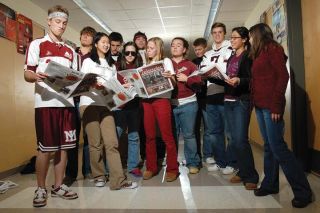Almost a year after the Mercer Island High School newspaper, The islander, encountered its first brush with censorship, the 27-member staff has shed past inhibitions and is ready to publish with gusto. With a flush of new page editors, The islander is in fresh hands once again. And, according to opinions editor Deborah Burstein, this year’s journalism class won’t be treading lightly.
“I don’t think any of us are really afraid of controversy,” the MIHS senior said, adding that her peers know the difference between appropriate and inappropriate content.
“So far, none of the administration has taken issue with anything we have done,” co-editor-in-chief Dave Morse added. “But we’re not approaching the paper with baby gloves or anything.”
In October 2006, the MIHS newspaper ran an archived photograph of four 2005 seniors playing bongo drums in the woods as a front-page teaser. All four of the students appeared to be naked, their anatomy strategically covered by three drums, a guitar and an open accordion.
The photograph, which ran the year before, had raised administrative concern for its provocative content. When it was first published in June 2005, superintendent Cyndy Simms said that the photograph was “inappropriate” and told newspaper class supervisor Jamie Prescott not to run the photo — nor similar images — again in the future.
When last year’s editorial stuck the 2-by-2 inch photo on the front page at the last minute, Prescott said she did not notice the teaser until it was too late. The papers had already been distributed throughout the school. After running to explain the situation to Vice Principal Craig Olson, Prescott asked her students to recollect the newspapers.
The islander staff were both disappointed and angry. In their opinion, the picture was harmless. Hoping to mediate the situation, Simms met with the paper to discuss the photograph and come up with some sort of compromise. She agreed that the staff could re-distribute the October issue with a jacket cover that explained the conflict on the front and outlined points made during their discussion on the back.
However, the explanatory jacket only inflated the issue as, in Simms’ opinion, it did not meet the guidelines she had gone over with islander staff. Furthermore, the superintendent did not approve of the students’ decision to stamp “CENSORED” across the front sleeve. And so the journalism class, exasperated at this point with what they deemed an “unfair” situation, begrudgingly got back to work on a new cover. In the end, the issue never went out.
“I don’t think that anyone really thought Simms’ argument was justified,” Burstein said. “Students didn’t find the photo inappropriate. They all just thought it was funny.”
During her conversation with the journalism class, Simms said the photo was inappropriate because, although only some bare skin was visible, the strategically placed instruments implied that the students were completely naked.
Despite the commotion the photograph raised — the Reporter covered the story in its Nov. 22 issue — this year’s islander staff considers it water under the bridge. Today they are focusing on ways to improve the paper and increase its popularity with MIHS students — even if that means printing another “risqu/” photograph.
“Basically, we made an implied oral agreement about what was and wasn’t appropriate, but that was it,” Burstein said, referring to the editorial’s 2006 conversation with Simms.
The senior pointed out that last year’s staff was supposed to sit down with the superintendent and write up a list of content rules and regulations, but this never happened.
“There is nothing really set in stone about what we can or cannot print,” said co-editor-in-chief Morgan Flake.
Both seniors emphasized that the paper is not out to shock. Islander writers are well aware of the difference between appropriate and inappropriate content, Flake pointed out, and strive toward a publication of quality and repute.
“Last year, the paper went through a big aesthetic change, from traditional [broadsheet] layout to tabloid style. So now we are focusing on the content of the paper — to make sure it’s consistently what the students want to read,” Morse said.
And what is it, exactly, that MIHS students want to read? According to Burstein, they are not interested in issues such as the Peak project or Bridges program. These topics have “already been fleshed out,” both in previous school papers and in the Reporter. In general, students want entertainment. Fading fads. Outrageous school spirit. Student affairs and school rumors. They want the scoop.
“We are trying to acknowledge the fact that we are a high-school newspaper and don’t need to really be cutting edge — it’s not like we have any competition,” Burstein said.
As for the paper’s personality, humor is — and has been for years — the apex of its content. Teenagers simply like to read funny stuff.
And if anything crass or offensive does make its way into the unedited paper, Prescott is there to voice the final ‘no.’
“Because it’s a student run paper, I would like them to have as much voice as possible,” she said. “However, we are sensitive to the fact that there is also [controversial] content, and when they want to try to push the envelope we have a discussion about why it may be offensive to certain groups and what the repercussions may be.”
The challenge of producing a quality newspaper, she added, comes in finding that balance between informative news and humor, especially within a school setting.
“It is a learning process,” Prescott said. “Hopefully, we’ve learned from our past mistakes and are growing as a paper and a staff.”


